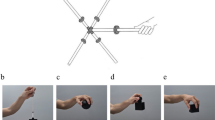Abstract
The brain can accurately predict the forces needed to efficiently manipulate familiar objects in relation to mechanical properties such as weight. These predictions involve memory or some type of central representation, but visual analysis of size also yields accurate predictions of the needed fingertip forces. This raises the issue of which process (weight memory or visual size analysis) is used during everyday life when handling familiar objects. Our aim was to determine if subjects use a sensorimotor memory of weight, or a visual size analysis, to predictively set their vertical lift force when lifting a recently handled object. Two groups of subjects lifted an opaque brown bottle filled with water (470 g) during the first experimental session, and then rested for 15 min in a different room. Both groups were told that they would lift the same bottle in their next session. However, the experimental group returned to lift a slightly smaller bottle filled with water (360 g) that otherwise was identical in appearance to the first bottle. The control group returned to lift the same bottle from the first session, which was only partially filled with water so that it also weighed 360 g. At the end of the second session subjects were asked if they observed any changes between sessions, but no subject indicated awareness of a specific change. An acceleration ratio was computed by dividing the peak vertical acceleration during the first lift of the second session by the average peak acceleration of the last five lifts during the first session. This ratio was >1 for the control subjects 1.30 (SEM 0.08), indicating that they scaled their lift force for the first lift of the second session based on a memory of the (heavier) bottle from the first session. In contrast, the acceleration ratio was 0.94 (0.10) for the experimental group (P < 0.011). We conclude that the experimental group processed visual cues concerning the size of the bottle. These findings raise the possibility that even with familiar objects we predict fingertip forces using an on-line visual analysis of size (along with memory of density), rather than accessing memory related to object weight.





Similar content being viewed by others
References
Cole K, Rotella D (2002) Old age impairs the use of arbitrary visual cues for predictive control of fingertip forces during grasp. Exp Brain Res 143:35–41
Brenner E, Smeets JBJ (1996) Size illusion influences how we lift but not how we grasp an object. Exp Brain Res 111:473–476
Flanagan JR, Wing AM (1997) The role of internal models in motion planning and control: evidence from grip force adjustments during movements of hand-held loads. J Neurosci 17:1519–1528
Flanagan J, Beltzner M (2000) Independence of perceptual and sensorimotor predictions in the size–weight illusion. Nat Neurosci 3:737–741
Flanagan JR, King S, Wolpert DM, Johansson RS (2001) Sensorimotor prediction and memory in object manipulation. Can J Exp Psychol 55:87–95
Goodale M (1993) Visual pathways supporting perception and action in the primate cerebral cortex. Curr Opin Neurobiol 3:578–585
Goodale M, Milner A, Jakobson L, Carey D (1991) A neurological dissociation between perceiving objects and grasping them. Nature 349:154–156
Goodale MA, Meenan JP, Buelthoff HH, Nicolle DA, Murphy KJ, Racicot CI (1994) Separate neural pathways for the visual analysis of object shape in perception and prehension. Curr Biol 4:604–610
Gordon AM, Forssberg H, Johansson RS, Westling G (1991a) Integration of sensory information during the programming of precision grip: comments on the contributions of size cues. Exp Brain Res 85:226–229
Gordon AM, Forssberg H, Johansson RS, Westling G (1991b) Visual size cues in the programming of manipulative forces during precision grip. Exp Brain Res 83:477–482
Gordon AM, Westling G, Cole KJ, Johansson RS (1993) Memory representations underlying motor commands used during manipulation of common and novel objects. J Neurophysiol 69:1789–1796
Jenmalm P, Johansson RS (1997) Visual and somatosensory information about object shape control manipulative fingertip forces. J Neurosci 17:4486–4499
Jenmalm P, Dahlstedt S, Johansson R (2000) Visual and tactile information about object-curvature control fingertip forces and grasp kinematics in human dexterous manipulation. J Neurophysiol 84:2984–2997
Jenmalm P, Schmitz C, Forssberg H, Ehrsson H (2006) Lighter or heavier than predicted: neural correlates of corrective mechanisms during erroneously programmed lifts. J Neurosci 26:9015–9021
Johansson RS, Westling G (1984) Roles of glabrous skin receptors and sensorimotor memory in automatic control of precision grip when lifting rougher or more slippery objects. Exp Brain Res 56:550–554
Johansson RS, Westling G (1988) Coordinated isometric muscle commands adequately and erroneously programmed for weight during lifting task with precision grip. Exp Brain Res 71:59–71
Salimi I, Frazier W, Reilmann R, Gordon A (2003) Selective use of visual information signaling objects’ center of mass for anticipatory control of manipulative fingertip forces. Exp Brain Res 150:9–18
Sinnaeve A, Dubrowski A, Carnahan H (2002) Evidence for the use of both iconic and long-term memory systems for friction when grasping. Soc Neurosci Abstr 28:2684
Wolpert DM, Kawato M (1998) Multiple paired forward and inverse models for motor control. Neural Netw 11:1317–1329
Wolpert DM, Ghahramani Z, Jordan MI (1995) An internal model for sensorimotor integration. Science 269:1880–1882
Author information
Authors and Affiliations
Corresponding author
Rights and permissions
About this article
Cite this article
Cole, K.J. Lifting a familiar object: visual size analysis, not memory for object weight, scales lift force. Exp Brain Res 188, 551–557 (2008). https://doi.org/10.1007/s00221-008-1392-y
Received:
Accepted:
Published:
Issue Date:
DOI: https://doi.org/10.1007/s00221-008-1392-y




